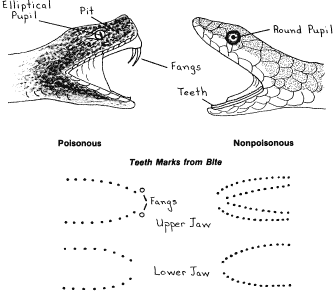said the little prince, 'is that somewhere it hides a well...”and snakes, “a funny animal, no thicker than a finger”, but "more powerful than the finger of a king”, and scorpions, and spiders.
All of this creatures are generally not a threat unless they are actually touched or stepped on. Use tips above to stay safe and know who are our neighbors in Wadi Rum.
Snakes are primarily nocturnal. They often become active during and immediately after desert rains, especially at night. In the heat of the day, they are usually either underground, or within or under cover (mammal burrows, shrubs, rocks and rock formations).
Saw-Scaled Viper, Echis carinatus. Threatened, forms its body into a crescent, and the scales are wound across one another in a continuous, undulating motion. The result is a chilling rasping noise that sounds like the wind blowing. Bites has been known to cause massive internal hemorrhaging and bleeding from all bodily openings.
The Desert Horned viper, Cerastes Cerastes or Egyptian Viper exhibits scale-rasping behavior similar to Saw-Scaled Viper. It fond of loose sand, and can disappear into in a matter of seconds - only the eyes, nostrils and horns remain above the surface. Bites from show hemotoxic effects and have great tissue-damaging qualities. Necrosis resulting from the envenomation resulted in the onset of gangrene, and a partial amputation could be required.
The Palestine Viper and The Lebetine Viper, Macrovipera Lebetina are very unlikely to be met in Wadi Rum. Their habitat is northern and central Israel, Palestine, western Syria, northwestern Jordan, and Lebanon.
False Cobra, Hooded Malpolon, الحفاث. Threatened, will imitate a cobra's stance by spreading its neck into a hood and hissing. The venom may not be deadly, but if the fangs do get hold of bare flesh and venom is injected, the pain can be excruciating; causing swelling and potentially other complications.
The Deathstalker (Leiurus quinquestriatus), also known as the Israeli Yellow scorpion, Omdurman scorpion or Naqab desert scorpion is the most dangerous. Its venom is a powerful mixture of neurotoxins, with a low lethal dose. While a sting from this scorpion is extraordinarily painful, it normally would not kill a healthy adult human
Buthus judaicus, عقرب There is a general conception that a sting of the yellow scorpion is dangerous, whereas 'black' scorpion stings are not, but because it can take up to 72 hours for the effects to wear off get to a doctor or hospital for a dose of antivenom as soon as possible. Light and dark brown scorpions are usually not poisonous at all.
Brown Recluse Spider you can find in shoes, inside dressers, in bed sheets of infrequently used beds, in clothes stacked or piled or left lying on the floor and inside work gloves -- watch carefully! It's venom can cause significant cutaneous injury with tissue loss and necrosis. Half of brown recluse bites result in necrosis or systemic effects. Systemic effects may occur before, as the venom spreads throughout the body in minutes. The systemic symptoms most commonly experienced include nausea, vomiting, fever, rashes, and muscle and joint pain.
Camel Spiders, Wind Scorpions, Sun Spiders, or Solifuges. عناكب جملية
Not especially large, the biggest having a leg span of about 12 cm, Camel Spiders are the subject of many legends - large, venomous predators, as fast as a running human, with a voracious appetite for large mammals.In fact they apparently have neither venom glands. Though they are not venomous, the powerful spider's jaws may inflict a painful nip.
Huntsman spider, Cerbalus aravaensis, عناكب صيادة is the largest spider in the Middle East. t has a leg span of 14 centimeters. Female members of this family will aggressively defend their egg sacs and young against perceived threats.
Latrodectus Revivensis, Widow Spider,الزوع (جنس من العناكب السامة) The female black widow has large venom glands and its bite can be particularly harmful to humans. Despite the genus' notoriety, bites are rarely fatal but cause severe muscle pain, abdominal cramps, hyperhidrosis, tachycardia, and muscle spasms. Symptoms usually last for 3–7 days, but may persist for several weeks. Since the venom is not likely to be life-threatening, antivenom has been used as pain relief and not to save lives. However, a study demonstrated that antivenom and placebo added to standardized pain medication had similar improvement in pain and resolution of symptoms.

Watch around and you will prevent almost all bites. And don't be too scared (or fascinated) -- you can spend a year in the desert and meet none of them, but anyway it's better to know.
When walking in the desert, wear boots or thick shoes and keep ankles and lower legs covered.
Don't lift up stones, don't poke about in crevices and do shake out your shoes, sandals or boots after overnighting.
Keep areas around clear of unnecessary debris and food.
Any building materials such as sheets of wood, rolls of cloth, etc. that have been sitting for more than a few hours should be flipped with a stick before being moved.
Always assume it is poisonous. Local first-aid clinics may or may not have anti-venom shots available.
The everyday diet of those Bedouin who continue to maintain a primarily nomadic way of life relies heavily on bread and dates, lamb, goat and occasionally camel meat and milk. The diet is low in vitamin A and D and most Bedouin got vitamin A from eggs and from Mallow plants (خبيزة). The whole plant is edible raw or cooked. Leaves make an excellent lettuce substitute and can also be cooked as greens. The leaves are mucus-forming, so when cooked in soups they tend to thicken it in much the same way as okra. A confection made from the root since ancient Egyptian time evolved into today's marshmallows. The roots were brought to the boil in water and then simmered until the water becomes quite thick. This liquid can then be whisked in much the same way as egg whites. A tea can be made from the dried leaves. Immature seeds are edible raw or cooked. Having a pleasant nutty flavor, they are nice as a nibble but too small in most cases to collect in quantity. Bedouins chop and fry leaves with salt, olive oil, and garlic.

Root should be collected from 2-year old plants, in autumn and leaves - just before flowering for highest mucilage.
Mallows contains Vitamin C and A, Calcium, Magnesium, Potassium, Iron and Selenium. All parts of common mallow are astringent, laxative, urine-inducing, and have agents that counteract inflammation, that soften and soothe the skin when applied locally, and that induce the removal (coughing up) of mucous secretions from the lungs. It's good for wasps and bee stings and for poisonous spiders bites.The decocted root is given to the wounded as a drink to quench thirst arising through loss of blood. It also applied with honey and raisin to hemorrhages, dislocation and swollen muscles. If meat are cooked with mallow, the peaces would be joined together. Boiled with vinegar ad used as a mouthwash, it helps toothache. Put the flowers in oil and mix them with tallow for use on sores. Make a compound infusion of plants applied as poultice to swellings of all kinds, and for broken bones. Apply it to babies' swollen stomach or sore back. Use the plant for painful congestions of the stomach. A cold infusion of plants used as a lotion for injuries or swellings. A cold infusion can be made, by soaking 6 teaspoons of the dry herb in a liter of cold water overnight, and then applied topically. According to some herbalists, the cold infusion likely extracts the plant’s mucilage (a soothing, gelatinous substance) most effectively and may work best for both internal and topical use. The root decocted in water until all the liquid has boiled away, leaving a sticky substance ad this applied to the abscess will also work
For tea boil 2 to 4 teaspoons of the dried leaves or flowers in 150 ml of boiling water for 10 to 15 minutes. One cup of the tea can be drunk three times per day.
The most common wormwoods of the Middle East are Artemisia Absinthium, Artemisia Judaica (بعثران) and Artemisia Arborescens (شيح), all of which have similar uses.

Bedouins believe that the fumes of wormwood will keep away the cosmopolitan evil eye. They use dry wooly galls from the wormwood to start fires. When newly born, inhale smoke from burning leaves to insure good health. For colds and cough they drink leaf tea, in water or milk. Egyptians use wormwood for tapeworms, Israelis and Palestinians use the leaves for toothache, Lebanese apply leaf macerate with shea and olive oil to cuts, dermatitis and lesions. North Africans use the plant to calm bleeding, cough, emotions, fever, headache, nerves, ophthalmia and stomach. Artemisia Herba-Alba is used in native perfumery.
Complete list of curative purposes includes:
intestinal worms, baldness, coagulation wounds, treating poisons from the bites and stings of venomous creatures, chills, coughs, hiccups, bad odors, intestinal worms, paralysis, muscle weakness, joint pains, stomach ache, heart pains, dissolving blood clots, increasing virility, soothing nerves, scabies, strengthen the appetite and the body during pregnancy, treat vomiting, kidney stones, suspended urination, disinfect the urinary tract and sexual organs, sexual stimulant, german measles, chicken pox and sores. And according to google translate it helps if you fall into the fat and doing a good beard ^_-
Wormwood tea can be made by adding ½ to 1 teaspoon (2.5 - 5 grams) of herb to 250 ml (one cup) of boiling water with dipping for 10 to 15 minutes. Several doctors have recommended to drink three cups of tea every day. You can also use the dye amount of 10-15 drops in water, and be dealt with 10 to 15 minutes before the meal. And any of the drugs must Estkhaddma for more than four consecutive weeks.
Two drops of wormwood extract equals one 8 oz. cup of tea.
You can put the drops of extract into a cup of hot water to make an instant tea!
Be careful! Contains a series of volatile oils, bitter principles and tannins that require it to be used with care. Overuse of wormwood can irritate the liver and kidneys, while some cases of overuse result in damage to the nervous system. Side effects after the long-term (more than four weeks) are nausea, vomiting, insomnia, anxiety, convulsions, vertigo and dizziness.
























